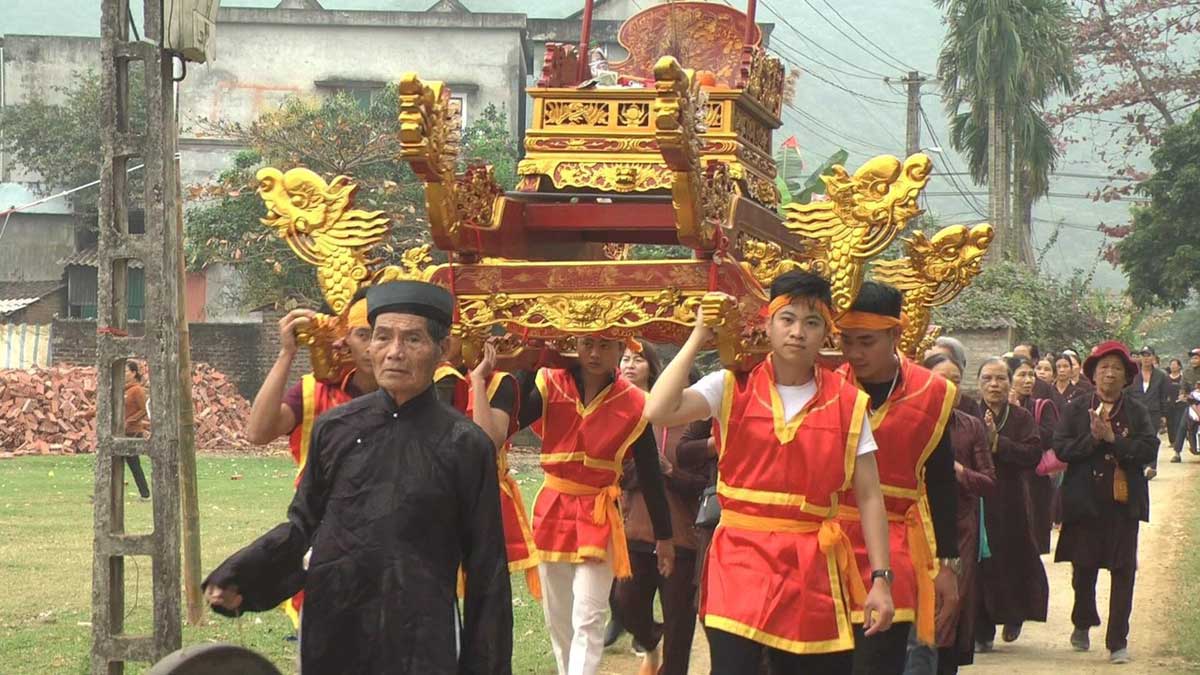
(HBO) - In the tourism development plan to 2020, with a vision to 2030, Yen Thuy set a goal of turning the district into a key attractive and safe spiritual and religious tourist destination of the locality.
 The Lieu communal house festival in Yen Thuy district’s Ngoc Luong commune is held every
year, attracting thousands of local tourists and those from other localities.
The Lieu communal house festival in Yen Thuy district’s Ngoc Luong commune is held every
year, attracting thousands of local tourists and those from other localities.
Good work in
preserving and promoting the value of traditional culture identities through the forming of public art clubs has contributed to
building a deep tourism image of the locality. The district has so far had 115 grassroots
art troupes.
According to Vice Chairman of the district People’s Committee Bui Van Hong, to
realise the set goals, the locality has given priority to developing infrastructure
facilities for tourist sites.
Notably, in the 2016-2020 period, the district has paid heed to mobilising
investment and integrating projects to upgrade a number of roads, while expanding
tourism markets, diversifying tourist products, promoting the locality’s image and
building tourist brands.
There is a traditional village specialising in producing liquor in Dinh hamlet,
Phu Lai commune, recognised by the provincial People's Committee. The district
is also home to 20 cooperatives producing clean agricultural products for
tourism development.
The district
has also actively participated in investment, trade and tourism promotion
activities, and regularly coordinated with communications agencies to promote its
landscapes, historical sites and traditional festivals.
Communications campaigns have been arranged to raise the awareness of locals
and tourists of the importance of protecting the environment.
Works for
waste treatment, clean water supply, environmental protection and climate
change response have been constructed in areas prioritised for tourism
development.
Meanwhile, the application of technologies has been promoted in tourism
business activities.
In
2020, the COVID-19 pandemic caused heavy
impact on the district’s tourism sector. Yen
Thuy district served 5,500 visitors in 2020, earning 4 billion VND in revenue,
equal to 33.33 percent of the plan set for the year.
Local authorities have implemented many solutions to
revitalise tourism activities and expand the tourism market, aiming to attract not
only spiritual tourists and pilgrims, but also travelers to natural landscapes
and ecotourism sites.
Attention will be continuously given to preserving and embellishing historical
and cultural values, and landscapes, and typical intangible cultural heritages;
and developing craft villages and popularising local specialties to visitors./.
A diverse chain of eco-tourism and resort destinations concentrated in Hoa Binh city and the districts of Tan Lac, Da Bac, and Luong Son… Along with the launch of several key high-quality resort tourism projects, these developments have reshaped the landscape and enhanced the appeal of Hoa Binh as a travel destination.
Boasting diverse terrain, a mild climate, and rich natural resources, Cao Phong district is increasingly asserting its place on Vietnam’s tourism map, attracting both domestic and foreign visitors. The district is renowned for its stunning landscapes, majestic mountains, a crystal-clear hydropower lake, and the unique cultural identity of local ethnic groups.
With its pristine landscapes, unique cultural heritage of Muong ethnic minority, and an expanding range of visitor experiences, Tan Lac district of Hoa Binh has fast become a captivating destination for both domestic and international tourists.
Until now, Sung village in Cao Son commune, Da Bac district remains the only Dao ethnic community in Hoa Binh province to develop a community-based tourism model. Beyond its untouched natural landscapes, cultural identity serves as the cornerstone attraction for visitors.
Alongside the diverse cultural identities of the Kinh, Muong, Tay, Thai, Dao, and Mong ethnic people, Hoa Binh province is also renowned as the "capital" of the northwestern Vietnamese cuisine, offering unique and distinctive dishes. At festivals, during Lunar New Year (Tet), or on significant family or community occasions, special dishes are prepared, leaving a lasting impression on visitors.
A Phong Linh (Yellow Tabebuia) flower garden in Thang village, Thach Yen commune, Cao Phong district is currently in full bloom, drawing a large number of visitors.



 The Lieu communal house festival in Yen Thuy district’s Ngoc Luong commune is held every
year, attracting thousands of local tourists and those from other localities.
The Lieu communal house festival in Yen Thuy district’s Ngoc Luong commune is held every
year, attracting thousands of local tourists and those from other localities.